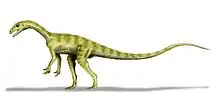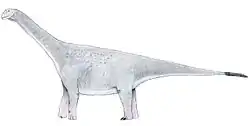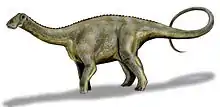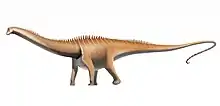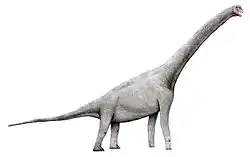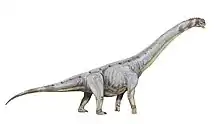Quaesitosaurus
Quaesitosaurus (meaning "extraordinary lizard") is a genus of nemegtosaurid sauropod containing only the type species, Q. orientalis, described by Kurzanov and Bannikov in 1983.[1] It lived from 85 to 70 million years ago during the Late Cretaceous (Santonian to Campanian ages). Its fossils, consisting solely of a partial skull, were found in the Barun Goyot Formation near Shar Tsav, Mongolia.[1] With long, low and horse-like with frontally located peg-teeth, the skull of Quaesitosaurus is similar enough to the skull of Diplodocus and its kin to have prompted informed speculation that the missing body was formed like those of diplodocids.[2]
| Quaesitosaurus | |
|---|---|
 | |
| Diagram showing known elements of the skull in brown | |
| Scientific classification | |
| Kingdom: | Animalia |
| Phylum: | Chordata |
| Clade: | Dinosauria |
| Clade: | Saurischia |
| Suborder: | †Sauropodomorpha |
| Clade: | †Sauropoda |
| Clade: | †Eusauropoda |
| Clade: | †Neosauropoda |
| Clade: | †Macronaria |
| Clade: | †Titanosauria |
| Clade: | †Lithostrotia |
| Family: | †Nemegtosauridae |
| Genus: | †Quaesitosaurus Kurzanov & Bannikov, 1983 |
| Species: | †Q. orientalis |
| Binomial name | |
| †Quaesitosaurus orientalis Kurzanov & Bannikov, 1983 | |
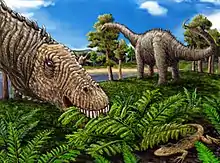
It is possible that Nemegtosaurus, also known from only skull material, is a very close relative of Quaesitosaurus.[2]
References
- Kurzanov, S. and Bannikov, A. (1983). "A new sauropod from the Upper Cretaceous of Mongolia". Paleontologicheskii Zhurnal 2: 90–96.
- Hunt, A.P., Meyer, C.A., Lockley, M.G., and Lucas, S.G. (1994) "Archaeology, toothmarks and sauropod dinosaur taphonomy". Gaia: Revista de Geociencias, Museu Nacional de Historia Natural, Lisbon, Portugal, 10: 225–232.
